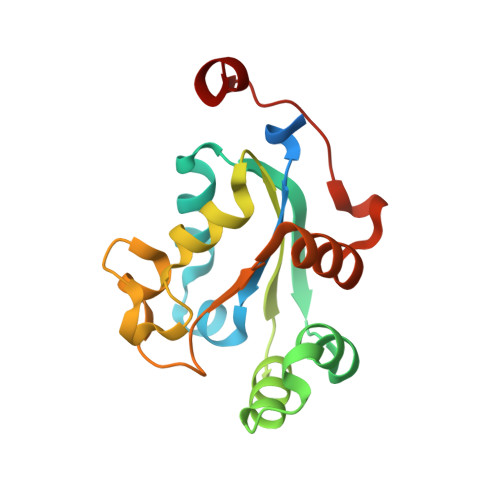A Unique Mode of Coenzyme A Binding to the Nucleotide Binding Pocket of Human Metastasis Suppressor NME1.
Tossounian, M.A., Hristov, S.D., Semelak, J.A., Yu, B.Y.K., Baczynska, M., Zhao, Y., Estrin, D.A., Trujillo, M., Filonenko, V., Gouge, J., Gout, I.(2023) Int J Mol Sci 24
- PubMed: 37298313
- DOI: https://doi.org/10.3390/ijms24119359
- Primary Citation of Related Structures:
8OOV - PubMed Abstract:
Coenzyme A (CoA) is a key cellular metabolite which participates in diverse metabolic pathways, regulation of gene expression and the antioxidant defense mechanism. Human NME1 (hNME1), which is a moonlighting protein, was identified as a major CoA-binding protein. Biochemical studies showed that hNME1 is regulated by CoA through both covalent and non-covalent binding, which leads to a decrease in the hNME1 nucleoside diphosphate kinase (NDPK) activity. In this study, we expanded the knowledge on previous findings by focusing on the non-covalent mode of CoA binding to the hNME1. With X-ray crystallography, we solved the CoA bound structure of hNME1 (hNME1-CoA) and determined the stabilization interactions CoA forms within the nucleotide-binding site of hNME1. A hydrophobic patch stabilizing the CoA adenine ring, while salt bridges and hydrogen bonds stabilizing the phosphate groups of CoA were observed. With molecular dynamics studies, we extended our structural analysis by characterizing the hNME1-CoA structure and elucidating possible orientations of the pantetheine tail, which is absent in the X-ray structure due to its flexibility. Crystallographic studies suggested the involvement of arginine 58 and threonine 94 in mediating specific interactions with CoA. Site-directed mutagenesis and CoA-based affinity purifications showed that arginine 58 mutation to glutamate (R58E) and threonine 94 mutation to aspartate (T94D) prevent hNME1 from binding to CoA. Overall, our results reveal a unique mode by which hNME1 binds CoA, which differs significantly from that of ADP binding: the α- and β-phosphates of CoA are oriented away from the nucleotide-binding site, while 3'-phosphate faces catalytic histidine 118 (H118). The interactions formed by the CoA adenine ring and phosphate groups contribute to the specific mode of CoA binding to hNME1.
Organizational Affiliation:
Department of Structural and Molecular Biology, University College London, London WC1E 6BT, UK.
















